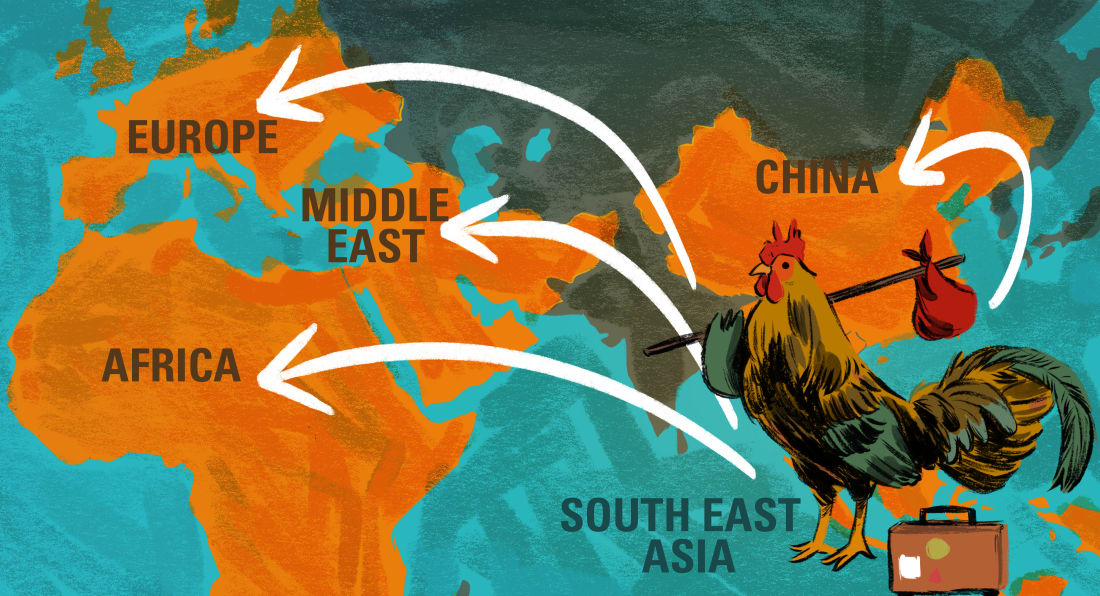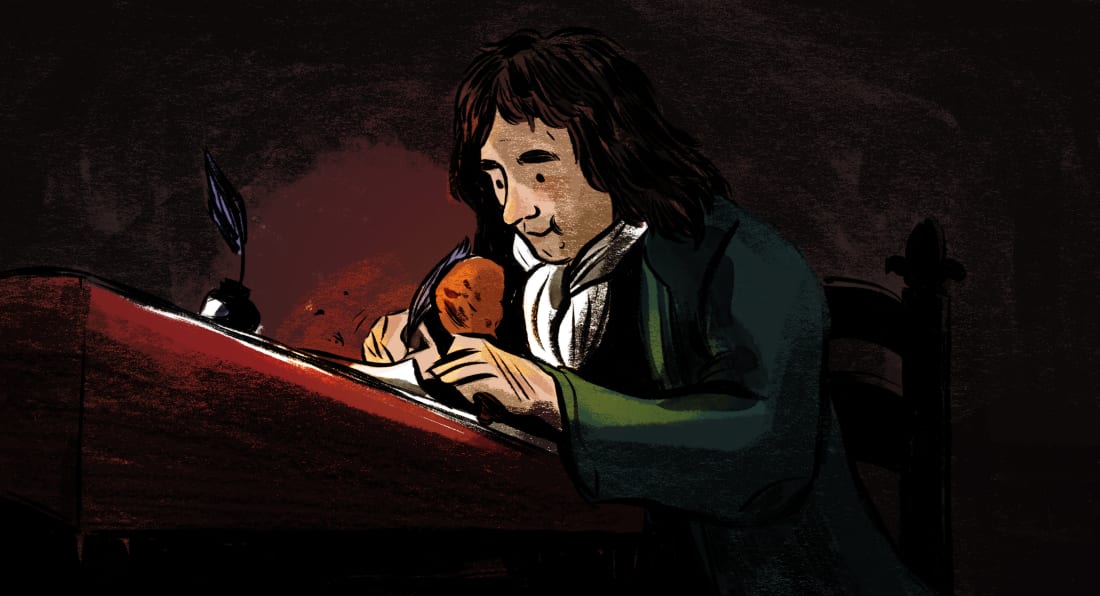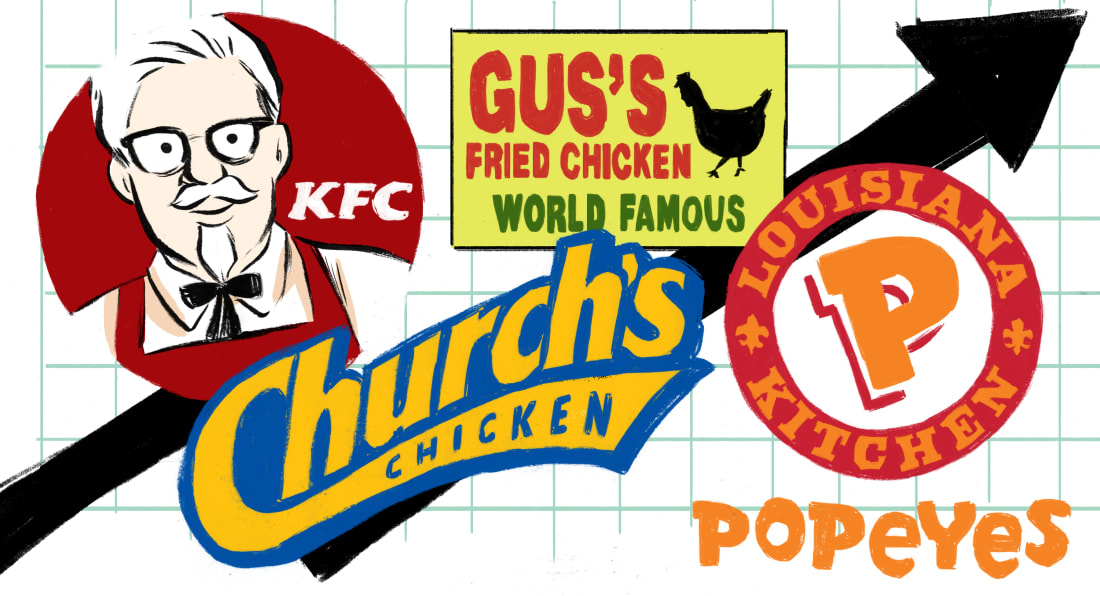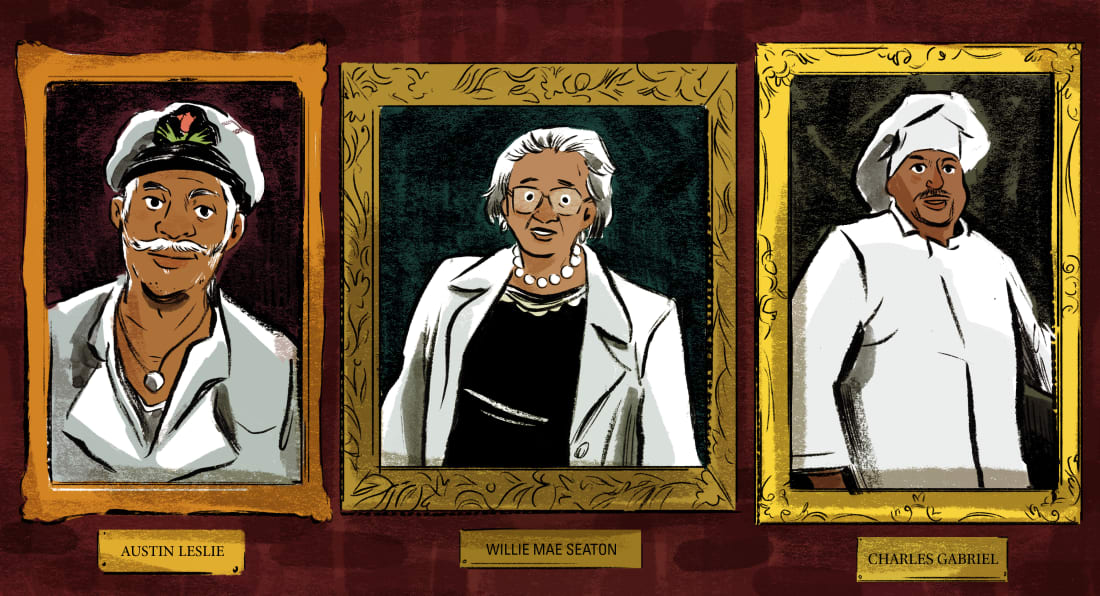Makassar, 31 August 2018

Phase 2: The Rise of American-Style Fried Chicken (1700s-1900s)

Phase 3: Fast-Food Fried Chicken Takes Flight (1950s-1980s)



Potatoes were first introduced to Europe not through the French or Belgians, but through the Spanish. In 1537, Jimenez de Quesada and his Spanish forces encountered a village in Colombia where all the natives had fled. Among other things, they found in the native’s food stuffs potatoes, which the Spanish initially called “truffles”.
- Fried Chicken
Fried chicken began as special occasion dish for many reasons. Chickens were scarce; they had value as egg producers (which made one think twice about eating them); and making this dish was very labor-intensive. Today, thanks to the vast-improvements in the poultry-farm and fast-food industries, fried chicken is one of the easiest and tastiest things to get any day of the week.
Here's the story of how fried chicken developed into an iconic dish, and why we can't seem to get enough of it.
Here's the story of how fried chicken developed into an iconic dish, and why we can't seem to get enough of it.
Phase 1: We Know Why the Caged Bird Fries (7,500-5,000 BCE)

Sometime between 7,500 to 5,000 B.C.E., humans living in Southeast Asia domesticated wild jungle fowl, or the ancestors of modern-day chickens (Gallus domesticus). At first, it was a 50/50 proposition if those jungle fowl would be eaten since many considered the fowl a divine animal. Why? Because it was believed that chickens could predict the future since they're the only animal that announces daybreak. Some experts believe that it was this sacred purpose that led the birds to be domesticated in the first place. As traders brought the sacred birds to other cultures, some bought into the bird's divinity, some saw chickens as entertainment (cock fighting), some saw chickens as food, while others held a hybrid belief that chickens were most appropriately sacrificed as a food for the gods.
Over time, people's penchant for cooking chicken overshadowed their other concerns, but it appeared initially on royal tables before climbing down the social ladder to be consumed by the masses. We see early accounts of fried chicken in China, the Middle East, and West Africa, but those dishes tended to be made with a "twice-cooked" approach, where the meat is butchered and quickly fried, and then braised in a liquid for a longer period of time. This was a very effective way to cook older chickens (hens) that were no longer of value for laying eggs. The preferred cooking method changed when fried chicken arrived in Great Britain and its American colonies.
Phase 2: The Rise of American-Style Fried Chicken (1700s-1900s)

Fried chicken history isn't well-documented, but some of the earliest references show up in surprising places. The earliest known written recipe for American-style fried chicken actually appears a in British cookbook, Hannah Glasse's The Art of Cookery Made Plain and Easy, which was published in 1747. That recipe's title read "To Marinate Chickens," and called for floured pieces of chicken to be fried in hog's lard. Glasse's cookbook was wildly popular on both sides of the Atlantic Ocean, so it's no surprise that her recipe became a prized way to make fried chicken in many well-to-do American households. Despite its British pedigree, people living in the 18th century associated fried chicken with the American South, no doubt because some of the dish's earliest and biggest boosters were southerners. For example, one earliest accounts of fried chicken-eating in the U.S. comes from the diary that Governor William Byrd of the Virginia colony kept during the 1700s. Ultimately, southern fried chicken became the culinary standard for American fried chicken when a recipe remarkably similar to Glasse's appeared in another extremely popular cookbook that was published in 1824—The Virginia Housewife, written by Martha Randolph, a distant relative in-law of Thomas Jefferson.
The downside of fried chicken becoming so identifiably southern is that it gave people license to create ugly, fried chicken-related stereotypes connected the South's largest racial minority: African Americans. Though lots of people were eating fried chicken, African Americans were negatively depicted in various media as pathological chicken stealers, pre-eminent chicken fryers, and voracious fried-chicken eaters. This was part of a concerted effort during the 19th century to de-humanize the newly-freed African Americans as unworthy of the citizenship rights recently conferred upon them. Unfortunately, that powerful stigma remains to the present day.
Phase 3: Fast-Food Fried Chicken Takes Flight (1950s-1980s)

Fried chicken transitioned from Sunday special to daily special with dramatic improvements in chicken farming. Chickens became more plentiful and cheaper to buy, which in turn made fried chicken something that could be eaten more often. That proved to be a winning combination for food entrepreneurs looking to make a fast buck on those who wanted their food prepared quickly. Along with hamburgers and pizza, fried chicken was ready for the moment, but there were still some logistics to work out. Traditional fried chicken takes time to be fully-cooked, up to 15 to 20 minutes. That's not fast food according to American standards.
Fortunately, some inventive people learned how to cook large quantities
of fried chicken quickly and keep it warm and crispy for customers to
eat on demand. The most well-known practitioner of this group was
"Colonel" Harland Sanders, who in the 1950s began franchising his
Kentucky Fried Chicken restaurant. Sanders' sizzling success coincided
with that of other regional fried-chicken restaurants like Harold's
Chicken Shack in the Chicago area, and it also paved the way for
successful national chains like Bojangles', Chick-fil-A, Church's, and
Popeyes. Despite its regional southern connection, fried chicken finally
transformed into a true national dish—although it didn't stop there
either. Today, thanks largely to KFC, people around the world can grub
on American-style fried chicken. It's hard to overstate KFC's
international influence. Not only does it have thousands of restaurants
overseas, but it has also inspired a number of knock-offs in foreign
countries, like "SFC"—Super Star Fried Chicken—in Iran.
Phase 4: Fried Chicken Gets Funky and Artisanal (1990s-2000s)

Perhaps in response to years of mass-market wings and thighs, Americans
have become intensely curious about regional fried-chicken culture.
First, there are the artisans who make such food possible. Typically,
these cooks spend years toiling at a small "mom 'n' pop" operation, but
occasionally evolve into full-on legends. The late Austin Leslie and
Willie Mae Seaton of New Orleans; the late Helen Stroud of Kansas City;
and Charles Gabriel in New York City come to mind. Today,
classically-trained chefs in white-table-cloth restaurants, like Thomas
Keller at Ad Hoc, also feel inspired to show off unique spins on this
classic American recipe.
The real creativity has come in pairing fried chicken with something
unexpected—like dry champagne or a savory waffle—or slathering the
finished product with something funky. The most famous example is the
red-hot—both in spiciness and trendiness—chicken created at Prince's Hot
Chicken in Nashville, Tennessee. Many restaurants across the country
are hatching their own version of hot chicken, and KFC, unsurprisingly,
has joined the bandwagon. And let's not sleep on that North Carolina
specialty known as "dipped chicken," which features fried chicken
drowned in a Western North Carolina-style barbecue sauce (vinegar, red
pepper, and a little ketchup).
Phase 5: International Fried Chicken Comes Home to Roost (2000s to Present)

When KFC and other franchises toured their American-style fried chicken
around the world, they never would have guessed that their product would
end up running in circles. Once introduced to American-style fried
chicken, international cooks put their own spin on it in order to suit
local tastes. Some cooks were so successful at reinterpreting the dish
that fried chicken ceased to be "American," instead becoming a new local
specialty. Today, when fried-chicken entrepreneurs immigrate to the
U.S., they bring either their old school, traditional version, or newer
riff on American-style poultry.
A great example is Pollo Campero, which has pleased many a homesick
Guatemalan with its adobo-seasoned fried chicken. But no immigrant fried
chicken has made as big a splash as South Korean-style, thanks to the
successful Bonchon chain and celebrity chef David Chang's mini Fuku
empire. Korean fried chicken is twice-fried, making it extra crispy, and
often covered with a spicy sauce that may sometimes also be sweet. Yet
we shouldn't think of Guatemala and South Korean as the end of the
story. The U.S. continues to welcome immigrants from heavy fried
chicken-eating countries in the Caribbean, the Middle East, and West
Africa. Fried chicken is a perfect playground for food entrepreneurs
because of its versatility, which creates an open invitation for
re-invention. We all should be salivating in anticipation.
Sources :
https://firstwefeast.com/features/2016/04/fried-chicken-illustrated-history
- French Fries
Potatoes were first introduced to Europe not through the French or Belgians, but through the Spanish. In 1537, Jimenez de Quesada and his Spanish forces encountered a village in Colombia where all the natives had fled. Among other things, they found in the native’s food stuffs potatoes, which the Spanish initially called “truffles”.
Around 20 years later, potatoes were brought back to Spain and also
introduced to Italy. At this time, the potatoes were still quite small
and bitter and didn’t grow well in either Spain or Italy. However, over
time, larger and less bitter versions of the plant were cultivated and
the plant gradually caught on elsewhere in Europe, though it was
initially met with quite a bit of resistance.
In any event, historical accounts indicate that the Belgians were
possibly frying up thin strips of potatoes as early as the late 17th
century (though some claim it wasn’t until the late 18th century) in the
Meuse Valley between Dinant and Liège, in Belgium. How they supposedly
came up with the idea was that, in this area, it was very common for the
people to fry up small fish as a staple for their meals. However, when
the rivers froze up thick enough, it tended to make it somewhat
difficult to get fish. So instead of frying up fish in these times, they
would cut up potatoes in long thin slices, and fry them up as they did
the fish.
Giving some credence to this story is that the Spanish controlled much
of what is now modern day Belgium at the time the Spanish introduced the
potato to Europe. So, at least, the Belgians probably were among the
first to have a crack at the potato, in terms of thinking up ways to
prepare food from potatoes.
Now to the French argument: the popularity of the potato in France is
largely credited to a French army medical officer named
Antoine-Augustine Parmentier, who very famously championed the potato
throughout France and parts of Europe. During the Seven Years War,
Parmentier was taken captive and, as a part of his prison rations, was
given potatoes.
At this time, the French had previously used potatoes only for hog feed
and never ate them. The reason being that they thought potatoes caused
various diseases. In fact, in 1748, the French Parliament even banned
cultivation of potatoes as they were convinced potatoes caused leprosy.
However, while in prison in Prussia, Parmentier was forced to cultivate
and eat potatoes and found the French notions about the potato just
weren’t true.
When he came back to France, Parmentier began championing the potato as a
potential food source. Finally, in 1772, the Paris Faculty of Medicine
proclaimed that potatoes were edible for humans, though Parmentier still
encountered significant resistance and wasn’t even allowed to grow
potatoes in his garden at the Invalides hospital where he worked as a
pharmacist.
Parmentier then began a more aggressive campaign to promote the potato
in France, hosting dinners featuring potatoes with such notable
dignitaries as Benjamin Franklin, Antoine Lavoisier, King Louis XVI, and
Queen Marie Antoinette. He also would hire armed guards to surround his
potato patch, to try to convince people that what was in the patch was
very valuable. He would then tell the guards to accept any bribes they
were offered by people and let them “steal” the potatoes. In the end
though, it took a famine in 1785 for the potato to become popular in
France.
Once the French accepted the potato though, its popularity skyrocketed
in France. By 1795, potatoes were being grown on a very large scale in
France, including at the royal gardens at Tuileries, where the gardens
were converted into potato fields. Within that span of time, the French
either invented or learned to make fries. Once discovered/invented
French fries became extremely popular in France, particularly in Paris,
where they were sold by push-cart vendors on the streets and called
“frites”.
Now, it should be noted that this all happened in the late 18th century,
which was as much as 100 years after some people say the Belgians were
supposedly already making “French” fries. But by other arguments, this
all happened around the same time for both the French and the Belgians.
So who knows?
It should also be noted that, shortly before the potato became popular
in France, the Franco-Austrian war was going on (also known as the War
of Austrian Succession), much of which took place around modern day
Belgium. So it’s possible that the French soldiers were introduced to
fries by the Belgians at this time and, a couple decades later when the
potato became popular in France, these former soldiers then introduced
the preparation method to the rest of France. Or it’s possible the
French came up with the idea on their own and spread them to Belgium
around the same time; or that both came up with the idea independently.
Whatever the case, it was the French who seem to be the ones that spread
fries to America and Britain and it, in turn, was the Americans,
through fast food chains, that eventually popularly introduced them to
the rest of the non-European world as “French fries”. Ironically,
because of this latter spread by American fast food chains, in many
parts of the non-European world, “French fries” are more often than not
known as “American fries”.
Bonus Facts:
- While the Belgians may or may not have invented the French fry, today,
they do consume the most French fries per capita of any country in
Europe.
In most of the English speaking world, thin cut and thick cut fries are
called two different things, fries and chips, respectively. In North
America, it is typical to simply call them all French fries and, when
they are distinguished, it is usually just by adding an adjective,
rather than using a completely different word: i.e. steak fries (chips),
French fries, curly fries, etc.
- In 1802, Thomas Jefferson had the White House chef, Frenchman Honoré
Julien, prepare “potatoes served in the French manner” for a dinner
party. He described these as “Potatoes deep-fried while raw, in small
cuttings”. (French fries at a White House state dinner…. classy.) This
is one of the earliest references to fried potato strips being referred
to as “French”.
- Steak fries, or chips, actually tend to have lower fat content than
normal French fries, due to the lower surface to volume ratio.
- Burger King’s French fries (and probably McDonald’s too) are sprayed
with a sugar solution just before being packaged and shipped to the
various franchise locations. This produces the golden color through
caramelization of the sugar when it is fried. Without this, the fries
would end up having about the same outside color as inside after being
fried.
- McDonalds is known to fry their fries twice, the combined time taking
about 15 to 20 minutes. Once for cooking the insides and once for making
them extra crispy on the outside.
- Popular condiments to dip French fries in varies quite a bit from
country to country. In America, ketchup is typically the dip of choice
for French fries. In certain parts of Europe, mayonnaise is king. - The
British tend to favor malt vinegar for dipping their fries. The French
themselves tend to just eat the fries straight as often as not. I
personally prefer Ranch or Blue Cheese dressing with highly salted
French fries.
- Belgians, who are the world’s connoisseurs when it comes to French
fries, occasionally will serve French fries with egg as a topping. The
raw egg is cracked over the French fries immediately after the fries
have been pulled from the fryer. This tends to mostly cook the egg, but
leaves the yoke somewhat runny for dipping the fries in.
- Cultivation of potatoes is thought to have started around the same
time as the start of the Common Era, around 2000 years ago in Peru and
Bolivia. It gradually spread from there throughout South America. These
early forms of the plant were fairly bitter and tuber-like.
- The word “potato” comes from the Haitian word “batata”, which was
their name for a sweet potato. This later came to Spanish as “patata”
and eventually into English as “potato”.
- The slang term for potato, “spud”, comes from the spade-like tool that is used to harvest the potatoes.
- When the potato was first introduced to Ireland and Scotland, it was
met with quite a bit of resistance from Protestants there, due to the
fact that the potato wasn’t mention anywhere in the Bible; thus, it
wasn’t clear whether it was acceptable to eat, so they refused to plant
them at first. The Catholics, on the other hand, chose to sprinkle them
with holy water before planting, thus making them acceptable to plant
and eat.
- Potatoes also met with resistance when first introduced to Europe as a
whole, due to the fact that the Europeans were convinced potatoes
caused a variety of diseases and were also thought to be poisonous.
Tomatoes also were thought to be poisonous by many, when first
introduced to Europe from the new world.
- Parmentier not only championed the potato, but he also was responsible
for the first mandatory smallpox vaccination in France in 1805, when he
was the Inspector-General of the Health Service under Napoleon.
- Parmentier was also the one who invented the French dish, Hachis
Parmentier, a variation of which is also sometimes called “Shepperd’s
Pie”. Hachis Parmentier is basically ground beef topped with mashed
potatoes and cheese. Variations on this dish include adding gravy, corn,
or other vegetables.
In addition to the above, Parmentier also founded a school of bread
making; was a pioneer in methods for extracting sugar from sugar beets;
and heavily researched food preservation methods, including
refrigeration.
- During the 19th century, Ireland was almost completely dependent on
the potato as the primary food source for most of its citizens. This
lead to the catastrophic potato famine of the 1840s when a certain
strain of fungus almost completely wiped out the potato in Ireland.
“To French”, in cooking, now commonly refers to cutting any food into
long thin strips. The origins of this phrase comes from the late 19th
century, so well after the term “French fried potato” was common.
- The French term “frite”, for fries, indicates deep frying, whereas, in
English, “fried” could mean deep frying, sautéing, or pan-frying.
Probably for this reason, “French fried”, has come to mean “deep-fried”
in English, regardless of what is being fried.
According to many of the “Belgian origin” supporters, French fries are
called French fries because, during WWI, American soldiers were
introduced to fries by the Belgians. At the time, the Belgian Army spoke
French. The fries were called “Les frites” (which is French) by the
Belgians and so the American soldiers took to calling them “French
fries”. This theory is incorrect, for a couple of reasons. First, as
mentioned, in the 1800s, Thomas Jefferson referred to fried potato
strips as “frying potatoes in the French manner”. In addition to this,
there is an American cookbook from the 1850s that specifically uses the
term “French Fried Potatoes” to describe French fries; there are also
numerous other references to “French Fried Potatoes” from the 1850s on,
in the United States; these all obviously pre-date WWI.
- Between the 1850s and 1930s, French fries were known more
illustratively as “French fried potatoes” in America. Around the 1930s,
everybody dropped the “potatoes” on the end and just called them French
fries.
Sources :
http://www.todayifoundout.com/index.php/2010/09/the-history-of-french-fries/
